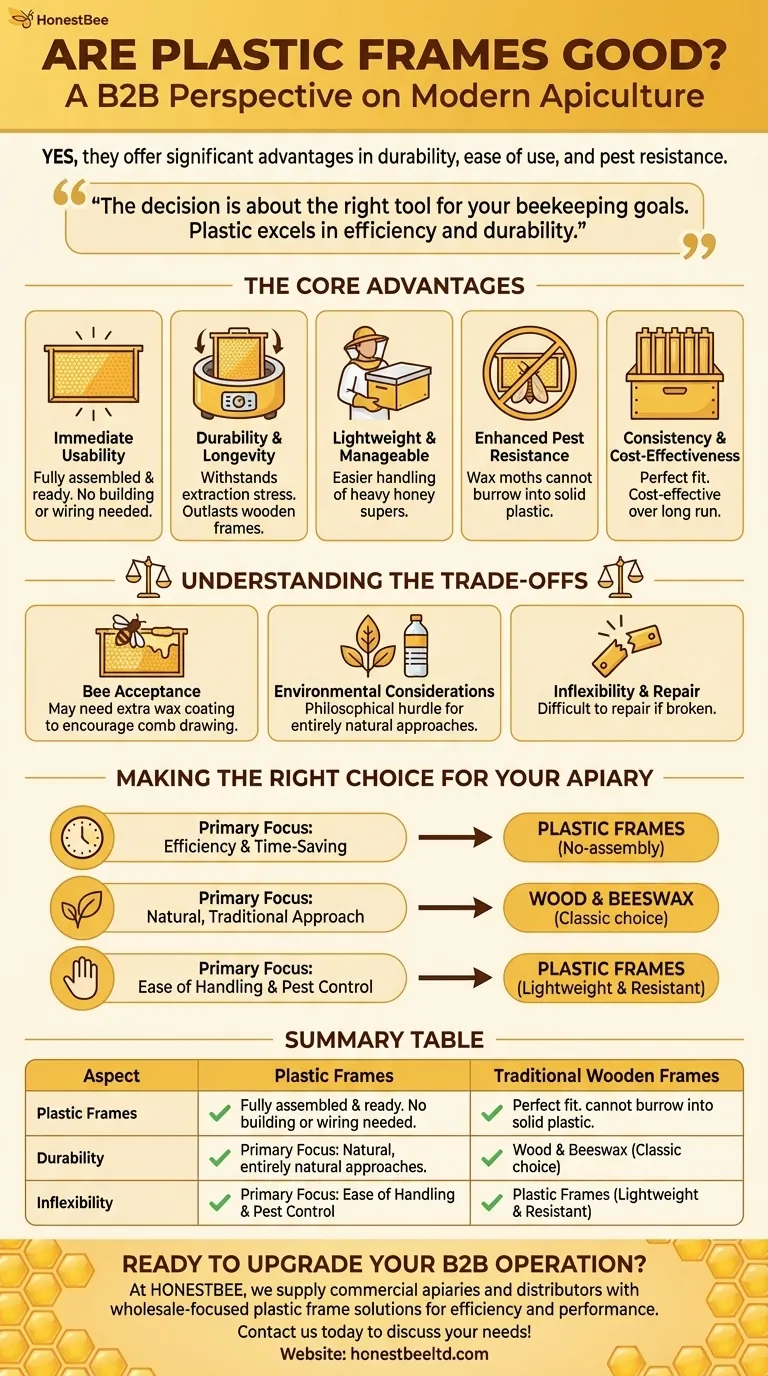Yes, for many beekeepers, plastic frames are an excellent choice. They offer significant advantages in durability, ease of use, and pest resistance right out of the box. While they represent a different approach from traditional wood, their practicality makes them a highly popular and effective option in modern apiculture.
The decision between plastic and traditional frames is not about which is universally "better," but which is the right tool for your specific beekeeping goals. Plastic excels in efficiency, durability, and pest control, making it a strong contender for both hobbyist and commercial operations.

The Core Advantages of Plastic Frames
The appeal of plastic frames comes down to a few key areas where they solve common problems faced by beekeepers using traditional wooden frames.
Immediate Usability
Plastic frames arrive fully assembled and ready to use. This eliminates the often time-consuming and tedious process of building and wiring wooden frames, allowing you to get new equipment into your hives immediately.
Durability and Longevity
These frames are tough. They are designed to withstand the stress of honey extraction in a centrifugal extractor, a process where wooden frames can sometimes break. A well-maintained plastic frame will typically outlast a wooden one.
Lightweight and Manageable
While a single frame is not heavy, a hive box full of honey is. Plastic frames are more lightweight than their wooden counterparts, making lifting and managing heavy supers of honey easier on the beekeeper.
Enhanced Pest Resistance
This is a critical advantage. Pests like wax moths cannot burrow into or consume solid plastic as they can with wood and wax. This inherent resistance can help slow the spread of invasive insects and protect your colony's comb.
Consistency and Cost-Effectiveness
Because they are mass-produced to standard sizes, plastic frames offer a perfect, uniform fit in your hive boxes every time. While the initial cost might be comparable to unassembled wood, their durability and lack of assembly time make them very cost-effective over the long run.
Understanding the Trade-offs
No piece of equipment is perfect for every situation. To make an informed decision, it's crucial to understand the potential downsides.
Bee Acceptance
Sometimes, bees are slower to draw out comb on brand-new, smooth plastic foundations. Many manufacturers now offer frames with a heavier wax coating to encourage acceptance, and beekeepers often add their own extra layer of melted beeswax to speed up the process.
Environmental Considerations
For beekeepers aiming for an entirely natural hive environment, introducing plastic is a philosophical hurdle. The decision to use plastic versus a renewable resource like wood is a personal one based on your management philosophy.
Inflexibility and Repair
Plastic is rigid. While it's very durable, if a plastic frame lug or side-bar does manage to break, it is effectively impossible to repair. A broken wooden frame, by contrast, can often be nailed or glued back into service.
Making the Right Choice for Your Apiary
Your specific goals should guide your equipment choices.
- If your primary focus is efficiency and time-saving: Plastic frames are the clear winner due to their no-assembly, ready-to-use design.
- If your primary focus is a natural, traditional approach: Wood and beeswax foundation remain the classic choice that aligns with an all-natural beekeeping philosophy.
- If your primary focus is ease of handling and pest control: The lightweight nature and pest-resistant qualities of plastic make it a superior choice, especially for new beekeepers.
Ultimately, choosing the right frame is about selecting the best system for your management style and the long-term health of your hives.
Summary Table:
| Aspect | Plastic Frames | Traditional Wooden Frames |
|---|---|---|
| Durability | High resistance to breakage in extractors | Can break under stress; repairable |
| Setup Time | Ready to use; no assembly required | Requires building, wiring, and assembly |
| Pest Resistance | Resistant to wax moths and burrowing pests | Vulnerable to pests without treatment |
| Weight | Lightweight; easier handling of heavy supers | Heavier, increasing physical strain |
| Bee Acceptance | May require extra wax coating for faster comb drawing | Naturally accepted by bees |
| Environmental Impact | Made from plastic; less natural | Renewable resource (wood) |
Ready to upgrade your beekeeping operation with high-quality, durable plastic frames?
At HONESTBEE, we specialize in supplying commercial apiaries and beekeeping equipment distributors with wholesale-focused solutions. Our plastic frames are designed to enhance your efficiency, reduce maintenance costs, and provide superior pest resistance.
Let us help you streamline your hive management with equipment built for longevity and performance.
Contact us today to discuss your wholesale needs and discover how HONESTBEE can support your apiary's success!
Visual Guide

Related Products
- Plastic Bee Frame Beekeeping Hive Frames for Wholesale
- Heavy-Duty Stainless Steel Clip-On Frame Perch
- Plastic Honey Comb Frames Cassette Box for Honey
- Assembled Wooden Bee Frames with Plastic Foundation for Durability and Convenience by HONESTBEE
- 7 x Auto Bee Flow Hive Frames Plastic Beekeeping Hive Box Supplies
People Also Ask
- What are the differences between wooden and plastic frames in beehives? Choose the Best for Your Apiary
- What is a general rule for beekeepers with many hives regarding frame choice? Maximize Efficiency with Plastic Frames
- Can beekeepers switch between wooden and plastic frames? Optimize Your Hive's Performance
- What are the advantages of plastic frames for beehives? Boost Apiary Efficiency & Durability
- What are the main types of frames available for beehives? Wood vs. Plastic for Your Apiary



















